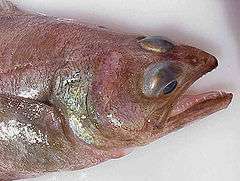Arrowtooth flounder
| Arrowtooth flounder (Atheresthes stomias) | |
|---|---|
 | |
 | |
| Scientific classification | |
| Kingdom: | Animalia |
| Phylum: | Chordata |
| Class: | Actinopterygii |
| Order: | Pleuronectiformes |
| Family: | Pleuronectidae |
| Subfamily: | Pleuronectinae |
| Genus: | Atheresthes |
| Species: | A. stomias |
| Binomial name | |
| Atheresthes stomias (D. S. Jordan & C. H. Gilbert, 1880) | |
| Wikimedia Commons has media related to Atheresthes stomias. |
The arrowtooth flounder, Atheresthes stomias, is a fish in the family Pleuronectidae, the right-eyed flounders. It can be caught from the Bering Sea to Santa Rosa Island, California. It is also at present the most common fish in the gulf of Alaska. Unfortunately, there is insufficient data on many general traits, including size and age of sexual maturity of the flounder. However, we do know spawning occurs from December through February. This species of flounder can live up to 25 years. If not properly handled, the flesh of arrowtooth flounder can soften, due to a proteolytic enzyme which is emitted from a myxoporean parasite that softens the flesh when heated. This in turn lowers its value and marketability. To make it more marketable, arrowtooth is usually sold on the West Coast as turbot, although it is not related to the true turbot. Recently scientists working at the Alaska Fisheries Development Foundation along with the National Marine Fishers service/utilization research and the Alaska sea food industry, have discovered a few food-based additives that inhibit this enzymatic breakdown. However, nothing has yet been developed which prevents this process entirely. Despite these setbacks Alaska Fisheries has gone on to make a specific arrowtooth fishing industry.
References
- Arrowtooth Flounder Research
- Froese, Rainer and Pauly, Daniel, eds. (2012). "Atheresthes stomias" in FishBase. October 2012 version.
- Arrowtooth Flounder Research
- The U.S.—A Leader in Sustainable Seafood